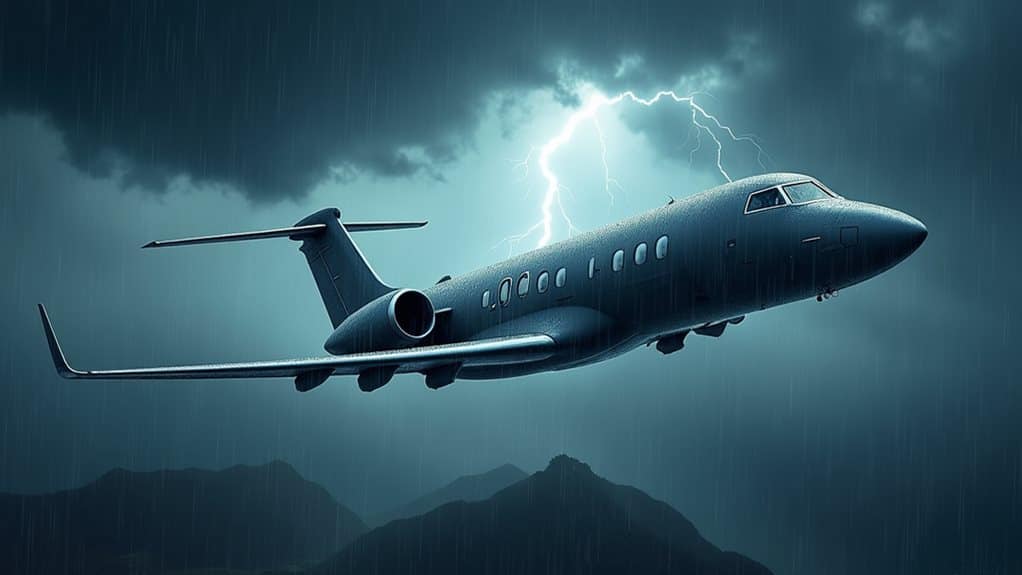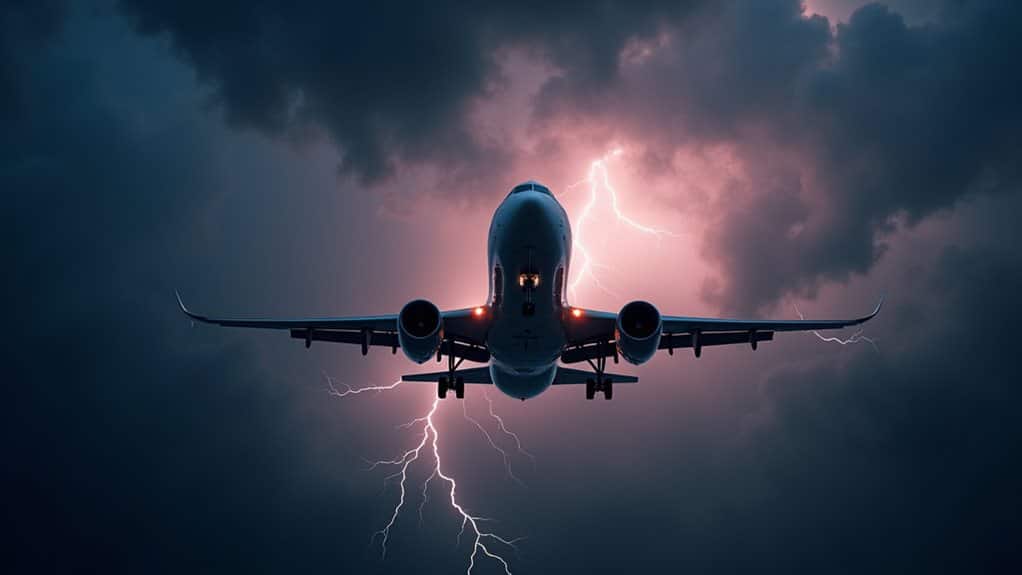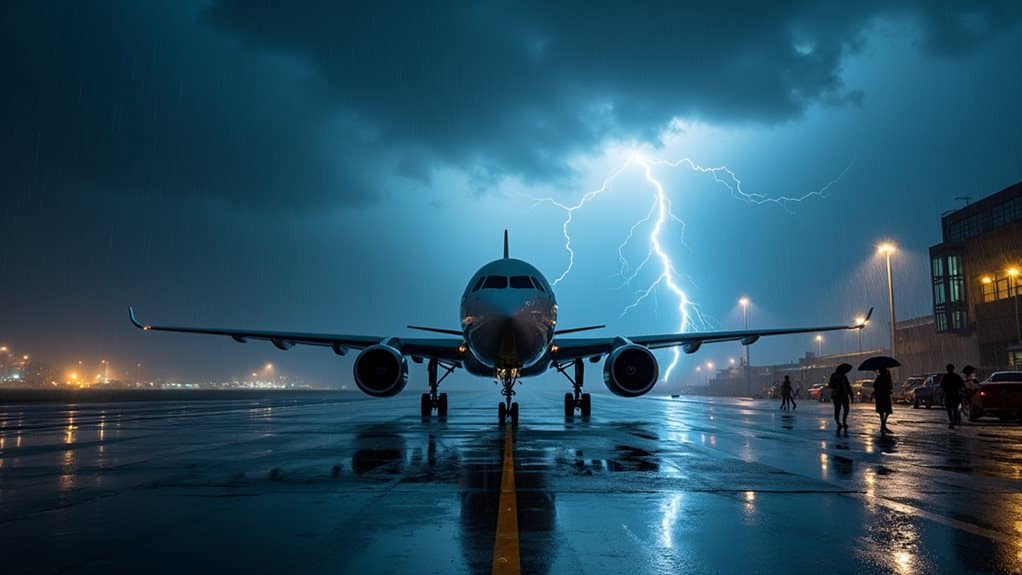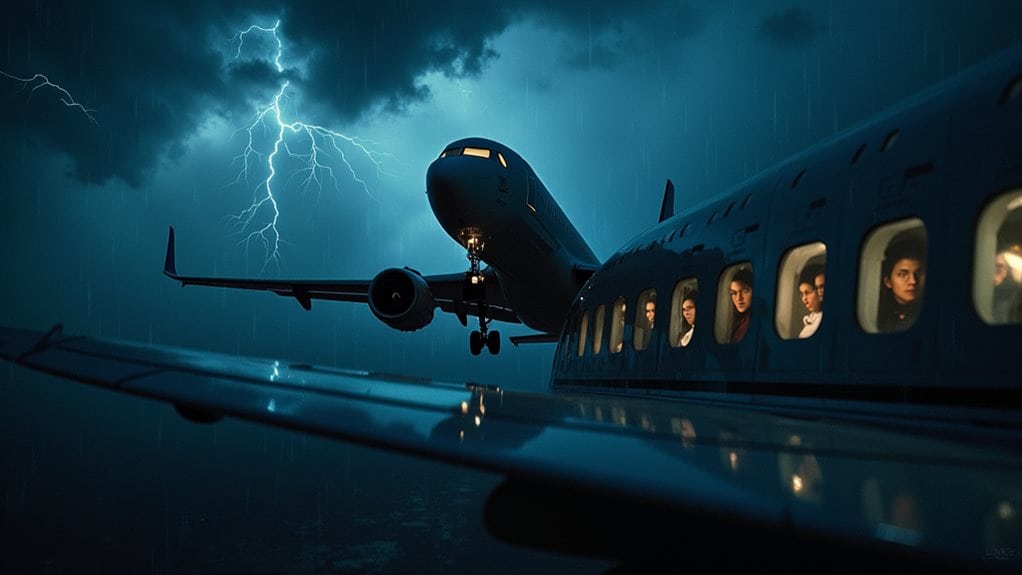Flying in thunderstorms is risky due to severe turbulence, wind shear, and potential lightning strikes. While modern aircraft are equipped with advanced technology like Doppler radar, pilots must exercise caution. They often reroute to avoid storms, maintaining a safe distance of at least 20 miles from severe cells. Flight cancellations and delays are common, affecting airline schedules considerably. If you’re curious about how pilots strategize to guarantee safety during these conditions, there’s more to investigate on this topic.
TLDR
- While planes can technically fly in thunderstorms, it poses significant risks such as severe turbulence and wind shear, which can affect control.
- Advanced technology, like Doppler weather radar, helps pilots detect and avoid hazardous thunderstorm cells in real time.
- Pilots should maintain a safe distance of at least 20 miles from severe thunderstorms to minimize risks during flight.
- Communication with air traffic control is crucial during storm conditions to ensure safety and proper navigation.
- Thunderstorms are a leading cause of flight cancellations and delays, accounting for approximately 41.98% of disruptions.
Understanding Thunderstorm Hazards for Aviation

When it comes to aviation, understanding the hazards posed by thunderstorms is essential for safety.
Thunderstorms form with moisture, lift, and atmospheric instability, leading to severe turbulence and wind shear. These conditions can cause loss of control and structural damage to aircraft. Different types of thunderstorms, such as supercells and squall lines, present unique challenges that pilots must be prepared to maneuver effectively. Supercells are particularly notorious for producing severe phenomena like tornadoes and hail, which can pose extreme risks to flying conditions. Additionally, thunderstorms account for approximately 10,000 flight cancellations annually in the U.S., emphasizing the importance of understanding these weather events for safe flight operations.
The Role of Modern Aircraft Technology
Modern aircraft utilize advanced Doppler weather radar systems to detect thunderstorm cells in real time. With these capabilities, you can expect pilots to receive vital updates that help them maneuver around hazardous weather conditions. This technology not only enhances safety but also allows for proactive adjustments to flight paths, ensuring a smoother trip even in turbulent skies. Moreover, the risks of severe weather extend several miles from the visible storm, necessitating the use of these advanced systems for effective navigation. Additionally, pilots may also rely on real-world experiences from previous flights to inform their decision-making during challenging weather scenarios.
Advanced Doppler Weather Radar
Advanced Doppler weather radar technology plays an essential role in enhancing flight safety, especially during thunderstorms.
It detects precipitation and measures wind speeds, helping pilots identify turbulence and severe weather.
With a detection range of up to 320 nautical miles and real-time data integration, this technology provides critical information for safe routing, reducing pilot workload and improving decision-making during challenging conditions.
Real-Time Weather Updates
Real-time weather updates have changed how pilots steer through challenging conditions like thunderstorms.
Technologies like SITA eWAS provide accurate, global data, helping you make informed flight adjustments. Continuous monitoring and alerts warn you about turbulence and icing, enhancing safety.
With AI-driven models and collaborative systems, you benefit from customized forecasts that optimize routes, ensuring safer and more efficient flights.
Flight Operations During Thunderstorm Conditions

When thunderstorms loom, flight operations require careful consideration to guarantee safety and efficiency.
Pilots face risks like turbulence, wind shear, and lightning strikes. If entering a storm is necessary, they should slow to maneuvering speed and avoid rapid altitude changes.
Communication with air traffic control is essential, along with using safety procedures to secure the aircraft and crew during turbulent conditions. Additionally, heavy rain combined with thunderstorms can significantly increase the likelihood of flight cancellations and delays.
Strategies for Avoiding Thunderstorms
To effectively avoid thunderstorms, pilots must prioritize extensive planning and situational awareness.
Conduct detailed preflight weather briefings and adjust routes to bypass stormy areas. Use onboard weather radar and monitor real-time updates from ATC and PIREPs.
Stay flexible, avoiding the urge to push through adverse conditions. Always maintain a safe distance—at least 20 miles—from severe thunderstorms to guarantee safety during flight operations. Additionally, ensure compliance with minimum fuel reserve requirements to accommodate any unplanned diversions due to weather changes.
Impact of Thunderstorms on Airline Schedules

Thunderstorms can considerably disrupt airline schedules, creating challenges that ripple through the entire flight operation system.
They account for about 41.98% of delays, with major airports like Newark Liberty experiencing up to 62.85% weather-related disruptions.
Rerouting and holding patterns lead to increased operational costs and passenger delays, making thunderstorms a significant factor in overall airline efficiency and scheduling.
Pilot Training and Safety Protocols
Understanding how pilots are trained to manage thunderstorms is essential for ensuring flight safety.
They receive extensive training on recognizing storm hazards, using weather radar, and making conservative decisions.
Pre-flight planning includes analyzing weather data and mapping diversion routes.
In-flight, pilots maintain a safe distance from storms and follow strict procedures to handle turbulence, ensuring effective communication with Air Traffic Control throughout.
Passenger Experience During Thunderstorm Disruptions

When thunderstorms disrupt air travel, passengers often face significant inconveniences that can greatly affect their overall experience.
You might find yourself stranded for hours on a plane or facing long delays due to cancellations. Airlines often issue refunds or accommodations, but the frustration of missed connections and crowded terminals can overshadow any compensation.
Effective communication can help mitigate some of these challenges during disruptions.
And Finally
In conclusion, while planes can fly in thunderstorms, safety remains the top priority. Modern aircraft are equipped with advanced technology to maneuver through these conditions, but avoiding thunderstorms is always preferable. Airlines and pilots follow strict protocols to guarantee passenger safety and minimize disruptions. Understanding these factors can help you feel more informed about your travel experience. Ultimately, being prepared and aware of potential weather impacts can enhance your trip, even in challenging conditions.



